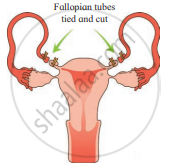Advertisements
Advertisements
प्रश्न
Answer the following question.
Describe the various methods of birth control to avoid pregnancy.
Write in detail any four temporary methods of birth control.
उत्तर
Contraceptive methods are of two main types i.e. temporary and permanent.
1. Temporary methods:
- Natural method/ Safe period / Rhythm method:
In the natural method, the principle of avoiding chances of fertilization is used. A week before and a week after menstrual bleeding is considered a safe period for sexual intercourse.
This method is based on the fact that ovulation occurs on the 14th day of the menstrual cycle. Drawback: High rate of failure. - Coitus Interruptus or withdrawal:
In this method, the male partner withdraws his penis from the vagina just before ejaculation, so as to avoid insemination.
Drawback: Pre-ejaculation fluid may contain sperms and this can cause fertilization. - Lactational amenorrhea (absence of menstruation):
This method is based on the fact that ovulation does not occur during the period of intense lactation following parturition. Therefore, as long as the mother breastfeeds the child fully, chances of conception are almost negligible.
Drawbacks: High chances of failure. - Chemical means (spermicides):
In this method, chemicals like foam, tablets, jellies, and creams are used by the female partner. Before sexual intercourse, if these chemicals are introduced into the vagina, they adhere to the mucous membrane, immobilize and kill the sperms.
Drawback: It may cause allergic reaction. This method also has chances of failure. - Mechanical means / Barrier methods:
In this method, the ovum and sperm are prevented from physically meeting with the help of barriers. These mechanical barriers are of three types.
- Condom:
It is a thin rubber sheath that is used to cover the penis of the male during copulation. It prevents the entry of ejaculated semen into the female reproductive tract. It can thus prevent conception. It is a simple and effective method and has no side effects. Condoms should be properly discarded after every use. A condom is also a safeguard against STDs and AIDS.
e.g.“Nirodh” is the most widely used contraceptive by males. It is easily available and is given free by the government. - Diaphragm, cervical caps and vaults:
These devices used by the female are made up of rubber. They prevent conception by blocking the entry of sperms through the cervix. The device is inserted into the female reproductive tract to cover the cervix during copulation. - Intra-uterine devices (IUDs):
These clinical devices are plastic or metal objects. A doctor or trained nurse places the IUDs into the uterus. These devices include the Lippes loop, copper releasing IUDs (Cu-T, Cu7, multiload 375), and hormone-releasing IUDs (LNG-20, progestasert).
- Lippes loop:
It is a plastic double “s” loop. It attracts the macrophages stimulating them to accumulate in the uterine cavity. Macrophages increase phagocytosis of sperms within the uterus and act as a contraceptive. - Copper-releasing IUDs:
Suppress sperm motility and the fertilizing capacity of sperms. - Hormone-releasing IUDs:
Make the uterus unsuitable for implantation and cervix hostile to the sperms. It delays pregnancy for a longer period.
Drawbacks: Spontaneous expulsion, occasional haemorrhage and chances of infection are the drawbacks of IUDs.
- Lippes loop:
- Condom:
- Physiological (Oral) Devices:
Physiological devices are used in the form of tablets/ pills. It is an oral contraceptive, used by the female which contains progesterone and estrogen. These hormones inhibit ovulation; hence no eggs are released from the ovary of the female using this pill and thus conception cannot occur.
They also alter the quality of cervical mucus to prevent the entry of sperms. The pill “Saheli” is an oral contraceptive for females which is non-steroidal. Saheli is to be taken once in a week. These pills are sponsored by the Government. Saheli is now a part of the National Family Programme as an oral contraceptive pill in India.
Drawback: Oral contraceptive pills have side effects such as nausea, weight gain, tenderness of breast, and slight blood loss between menstrual periods. - Other contraceptives:
The birth control implant is a contraceptive used by the female. e.g. implanon, explanon, etc. It is a tiny, thin rod about the size of a matchstick. It is implanted under the skin of the upper arm and contains progesterone and estrogen. Their mode of action is similar to that of pills. They prevent pregnancy for 3-4 years.
2. Permanent Methods:
The permanent birth control method in men is called vasectomy and in women it is called tubectomy. These are surgical methods, also called sterilization. In vasectomy a small part of the vas deferens is tied and cut. In tubectomy, a small part of the fallopian tube is tied and cut. This blocks gamete transport and prevent pregnancy.


APPEARS IN
संबंधित प्रश्न
What are the suggested reasons for population explosion?
Is the use of contraceptives justified? Give reasons.
Correct the following statement:
Oral pills are very popular contraceptives among the rural women.
Which of the following is a hormone releasing IUD?
What is the term used for the gonorrhoea infection caused to girls before puberty?
Choose the correct option:
Sterilisation techniques are generally fool proof methods of contraception with least side effects. Yet, this is the last option for the couples because:
- It is almost irreversible
- Of the misconception that it will reduce sexual urge/drive
- It is a surgical procedure
- Of lack of sufficient facilities in many parts of the country
Emergency contraceptives are effective if used within ______.
The correct surgical procedure as a contraceptive method is ______.
The present population growth rate in India is alarming. Suggest ways to check it.
Mention two advantages of lactational amenorrhea as a contraceptive method.
